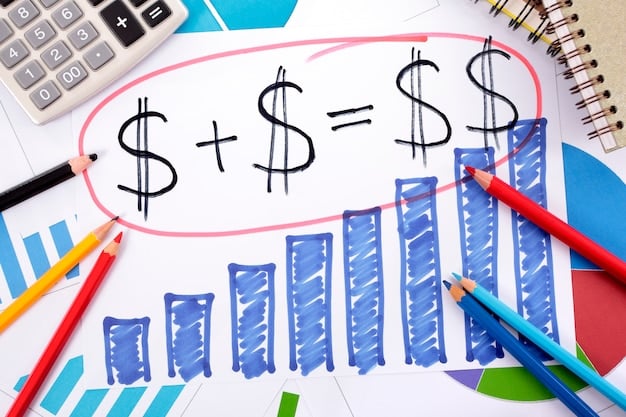Tax-Smart Investing: Minimize Capital Gains Taxes in 2025

Tax-smart investing in 2025 involves strategically managing investments to minimize capital gains taxes through methods like tax-loss harvesting, utilizing tax-advantaged accounts, and understanding holding periods to optimize tax rates.
Navigating the world of investments can be complex, especially when considering the impact of taxes. In 2025, employing tax-smart investing: how to minimize capital gains taxes strategies is more crucial than ever to protect your investment gains and maximize your financial returns.
Understanding Capital Gains Taxes
Capital gains taxes are levied on the profit you make from selling an asset, such as stocks, bonds, or real estate. Understanding how these taxes work is the first step in developing a tax-smart investment strategy.
The rate at which capital gains are taxed depends on how long you held the asset before selling it.
Short-Term vs. Long-Term Capital Gains
The distinction between short-term and long-term capital gains is crucial for tax planning.
- Short-term capital gains: These are profits from assets held for one year or less. They are taxed at your ordinary income tax rate, which can be significantly higher.
- Long-term capital gains: These are profits from assets held for more than one year. They are taxed at lower rates, typically 0%, 15%, or 20%, depending on your taxable income.
Therefore, holding assets for longer than a year can result in substantial tax savings.

Capital gains taxes can significantly impact your investment returns. By understanding the rules and implementing tax-smart strategies, you can keep more of your money working for you.
Tax-Advantaged Accounts: Your First Line of Defense
Tax-advantaged accounts are powerful tools for minimizing capital gains taxes. These accounts offer various tax benefits, making them essential components of any tax-smart investment strategy.
Here are some key tax-advantaged accounts to consider:
401(k) and IRA Accounts
These retirement accounts offer different tax advantages:
- 401(k): Contributions are made before taxes, reducing your current taxable income. Earnings grow tax-deferred, and withdrawals in retirement are taxed as ordinary income.
- Traditional IRA: Similar to a 401(k), contributions may be tax-deductible, earnings grow tax-deferred, and withdrawals are taxed in retirement.
- Roth IRA: Contributions are made after taxes, but earnings grow tax-free, and qualified withdrawals in retirement are also tax-free. This can be particularly beneficial if you anticipate being in a higher tax bracket in retirement.
Choosing the right type of retirement account depends on your individual circumstances and tax situation.
Health Savings Accounts (HSAs)
HSAs offer a triple tax advantage:
- Contributions are tax-deductible.
- Earnings grow tax-free.
- Withdrawals for qualified medical expenses are tax-free.
HSAs can be an excellent way to save for healthcare expenses while reducing your tax burden.
Tax-advantaged accounts provide a shield against capital gains taxes by allowing your investments to grow without being subject to annual taxation. Choosing the right accounts can significantly enhance your long-term investment returns.
Tax-Loss Harvesting: Turning Losses into Opportunities
Tax-loss harvesting is a strategy that involves selling investments at a loss to offset capital gains. This can help reduce your overall tax liability.
Here’s how it works:
The Basics of Tax-Loss Harvesting
The process involves selling losing investments and using the losses to offset gains.
- Identify losing investments: Review your portfolio to identify investments that have decreased in value.
- Sell the losing investments: Sell these assets to realize the capital losses.
- Offset capital gains: Use the losses to offset any capital gains you have realized during the year.
- Reinvest: You can reinvest the proceeds into similar assets, as long as they are not “substantially identical” to the ones you sold (to avoid the wash-sale rule).
Tax-loss harvesting can be an effective way to reduce your tax bill without significantly altering your investment strategy.
Wash-Sale Rule
The wash-sale rule prevents you from immediately repurchasing the same or a substantially identical investment within 30 days before or after the sale.
Violating the wash-sale rule will disallow the capital loss deduction. To avoid this, you can reinvest in a similar but not identical asset or wait more than 30 days to repurchase the original investment.

Tax-loss harvesting can be a valuable tool for minimizing your tax liability. By carefully managing your portfolio and understanding the wash-sale rule, you can strategically use losses to offset gains.
Asset Location: Strategically Placing Investments
Asset location involves strategically placing different types of investments in different accounts to minimize taxes. This strategy takes advantage of the tax benefits offered by various accounts.
Here’s how to approach asset location:
Keep tax-inefficient assets in tax-advantaged accounts.
Keep tax-efficient assets in taxable accounts.
Coordinate with overall investment strategy.
Tax-efficient investments, such as index funds, should go into your standard brokerage account. Tax-inefficient investments, such as bonds or real estate, should go into tax-advantaged accounts. By doing this, you will have a greater return on investments.
Asset location can optimize your tax efficiency. Consider seeking advice from a financial advisor to ensure your asset location strategy aligns with your overall financial goals.
Qualified Dividends: Taking Advantage of Lower Tax Rates
Qualified dividends are taxed at lower rates than ordinary income, similar to long-term capital gains. Understanding the rules for qualified dividends can help you minimize your tax liability.
Here’s what you need to know:
Requirements for qualified dividends.
How to identify qualified dividends.
Benefits of qualified dividends.
Only dividends from US-based or qualified foreign corporations are considered qualified dividends. Your brokerage can easily identify which dividends are qualified on your 1099-DIV statement.
In summary, qualified dividends are taxed at a much lower rate than other income, which gives investors a return on their stocks. If you plan to invest in 2025, you will want to have qualified dividends in your investment porfolio.
Year-End Tax Planning: Setting the Stage for 2025
Year-end tax planning is crucial for optimizing your tax situation and preparing for the upcoming year. Taking proactive steps before the end of the year can help you minimize your tax liability in 2025.
Here are some key strategies to consider:
Review your tax situation.
Make charitable contributions.
Consider Roth conversions.
Year-end tax planning allows you to proactively manage your tax situation. By carefully reviewing your finances and taking advantage of available strategies, you can set the stage for a tax-efficient 2025.
| Key Point | Brief Description |
|---|---|
| 💰 Tax-Advantaged Accounts | Use 401(k)s, IRAs, and HSAs to shield investments from taxes. |
| 📉 Tax-Loss Harvesting | Offset capital gains by selling losing investments. |
| 📍 Asset Location | Strategically place assets in different accounts to minimize taxes. |
| 📅 Year-End Planning | Review your tax situation and make adjustments before year-end. |
Frequently Asked Questions
▼
Capital gains taxes are taxes on the profit from selling assets like stocks, bonds, or real estate. The rate depends on how long you held the asset.
▼
Tax-loss harvesting involves selling losing investments to offset capital gains, reducing your overall tax liability. Just watch out for the wash-sale rule!
▼
Tax-advantaged accounts, like 401(k)s and IRAs, offer tax benefits such as tax-deferred growth or tax-free withdrawals in retirement.
▼
The wash-sale rule prevents you from claiming a loss if you repurchase the same or substantially identical investment within 30 days.
▼
Asset location involves strategically placing investments in different accounts to maximize tax benefits, such as holding tax-inefficient assets in tax-advantaged accounts.
Conclusion
Investing in a tax-smart way requires a blend of knowledge, strategy, and proactive planning. As you look ahead to 2025, remember to leverage tax-advantaged accounts, implement tax-loss harvesting, consider asset location, and engage in year-end tax planning to minimize your capital gains taxes and maximize your investment returns.





